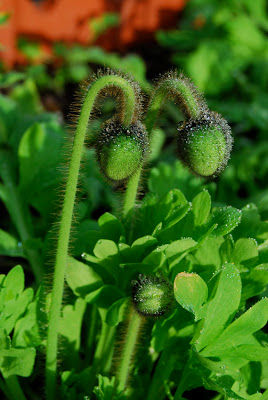Out the front of our house, a mugger lurks. Like a yappy little dog it's not really a danger to anyone, but some people in our street occasionally get accosted by it, if they're not looking where they're going. The mugger is our 'groundcover' plant, a prostrate form of the Cootamundra wattle, Acacia baileyana. At is has once more begun its sporadic little midwinter flower show, it's the right time to point my camera at it and celebrate one of the real personalities in our garden.
 Here's the mugger at work, spilling over the front fence. I'm constantly cutting it back, as it very rapidly makes its way through the fence and down to the footpath. It's advertised as a 'prostrate form' groundcover, but confined by hedges on all sides it rears up a metre high in all directions and fills the front garden with its lovely, feathery, blue-green foliage.
Here's the mugger at work, spilling over the front fence. I'm constantly cutting it back, as it very rapidly makes its way through the fence and down to the footpath. It's advertised as a 'prostrate form' groundcover, but confined by hedges on all sides it rears up a metre high in all directions and fills the front garden with its lovely, feathery, blue-green foliage. The first yellow puff-ball flowers appeared only two days ago, and they're always a delight to discover, but as our front garden faces south-west and is almost completely shadowed by the house for the three months of winter, its flowering is never spectacular. At best it's sporadic but it still attracts all the regular passers-by, many of whom stop and touch the blooms as if they were a little pet to pat.
The first yellow puff-ball flowers appeared only two days ago, and they're always a delight to discover, but as our front garden faces south-west and is almost completely shadowed by the house for the three months of winter, its flowering is never spectacular. At best it's sporadic but it still attracts all the regular passers-by, many of whom stop and touch the blooms as if they were a little pet to pat. As mentioned earlier, the foliage of this plant is sublimely beautiful, delicate and of a very Australian colour. If I saw this blue-green anywhere in the world I would think of home.
As mentioned earlier, the foliage of this plant is sublimely beautiful, delicate and of a very Australian colour. If I saw this blue-green anywhere in the world I would think of home. While I'm out the front of the house for a rare blog visit streetside, I might as well introduce you to our chubby little hedge, a lilly pilly by the name of 'Tiny Trev'.
While I'm out the front of the house for a rare blog visit streetside, I might as well introduce you to our chubby little hedge, a lilly pilly by the name of 'Tiny Trev'. Most of the year, Trev is a rich, deep green colour, but every winter it always puts on a delicious flush of new growth blushing a much redder colour than at other times of year.
Most of the year, Trev is a rich, deep green colour, but every winter it always puts on a delicious flush of new growth blushing a much redder colour than at other times of year. It's a shame the red foliage doesn't last all year – wouldn't it be lovely to have a red hedge! But a few weeks from now the party will finish and the sensible greens will take over duty as Mr T. Trev, the little hedge man. It's only then we'll give the hedge its next trim. For the meantime I'm happy for it to be a red-faced and chubby-cheeked member of the pack of native plants which accost passers-by in this ordinary suburban street.
It's a shame the red foliage doesn't last all year – wouldn't it be lovely to have a red hedge! But a few weeks from now the party will finish and the sensible greens will take over duty as Mr T. Trev, the little hedge man. It's only then we'll give the hedge its next trim. For the meantime I'm happy for it to be a red-faced and chubby-cheeked member of the pack of native plants which accost passers-by in this ordinary suburban street.








































